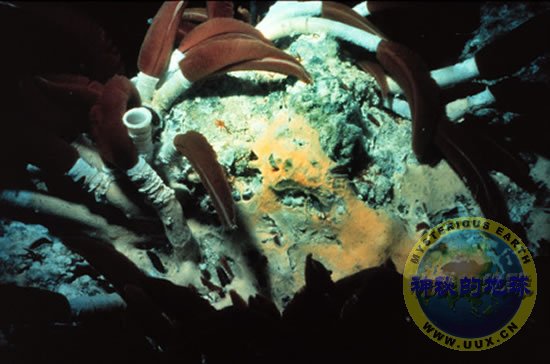Toxic Deep-Ocean Water Triggered "Great Dying"
Tube worms cluster around a hydrothermal vent in the Pacific Ocean in an undated photo.
This deep-sea ecosystem harbors bacteria that are anaerobic, or do not depend on oxygen for survival. In warmer conditions, anaerobic bacteria can produce toxic hydrogen sulfide.
A new study suggests that a warming of ocean water 251 million years ago spurred toxic upwellings of hydrogen sulfide, which may have been responsible for Earth's largest mass extinction, known as the "Great Dying."
Photograph courtesy C. Van Dover/OAR/National Undersea Research Program (NURP); College of William & Mary
Helen Scales
for National Geographic News
November 26, 2007
The finger of blame for the greatest mass die-off in Earth history points to a slow, drawn-out demise that came from below, a new study shows.
Researchers discovered that bryozoans—a common type of colonial marine creature also known as "moss animals"—began slowly declining in oceans across the world many millions of years before the mass-extinction event at the end of the Permian period about 251 million years ago.
(Related news: "Mystery Undersea Extinction Cycle Discovered" [March 9, 2005].)
This so-called Great Dying event wiped out about 90 percent of marine species and 70 percent of land species.
"It was a very gradual process," said Catherine Powers, a paleobiologist from the University of Southern California who co-authored a study on the new finding.
The first to go were the deeper-dwelling animals, followed by the shallow-water inhabitants.
"It indicates that something from the deep ocean is coming up," Powers said.
"Whatever killed these organisms and probably led to this mass extinction is tied to ocean circulation processes."
Toxic Upwellings
Bryozoans form an excellent "environmental dipstick" for studying the effects of mass extinctions, Powers said.
"They live in all sorts of marine environments, from tropical reefs to muddy shallow waters [to] the deep sea," she said.
"And they respond to environmental factors, with different growth forms dominating under different conditions."
The most likely culprit for the gradual bryozoan die-offs was the upwelling of toxic water unleashed from the deep ocean by rising global temperatures.
At the time, "there was massive volcanism in Siberia, which threw up lots of carbon dioxide into the atmosphere—leading to global warming," Powers said. The warming of surface water decreased the oceans' ability to absorb oxygen, she said.
This caused the upwelling of toxic hydrogen sulfide, which is produced by deep-ocean bacteria that don't use oxygen to survive.
With a mix of low oxygen, high carbon dioxide, and high hydrogen sulfide, the ocean was "a bit of a witches' brew coming out of deeper water," said study co-author David Bottjer of the University of Southern California.
Co-author Powers said the atmosphere and oceans are always interacting.
"So it is likely that toxic fumes of hydrogen sulfide diffused out of the oceans, [killing] land-based animals, which plummeted by 70 percent in the same mass extinction event."
Margaret Fraiser, a paleoecologist from the University of Wisconsin at Milwaukee, was not involved in the study.
"Until now we've [only] had geochemical and sedimentological evidence for these environmental perturbations towards the end of the Permian," she said.
"Now we have this biological information on how these organisms responded to that stress."
Other theories behind the Permian extinction involve volcanic eruptions and meteors.
(Related news: "Did Million-Year-Long Eruptions Cause Mass Extinction?" [May 2, 2006].)
"A lot of extinction mechanisms recently proposed for the end of the Permian have all focused on short, sharp, sudden catastrophic things, like very intense volcanism and meteorite impacts," said Paul Wignall, a paleoecologist at the University of Leeds in the United Kingdom.
Even if such cataclysmic impacts did take place, "they were superimposed on a background of pretty stressful conditions anyway," he said.
This study, Wignall commented, is "making the pendulum swing back the other way, away from the idea that everything happened in an instant."
Repeat Performance?
The study, which appears in this month's issue of the journal Geology, raises the issue of how modern-day global warming will affect life in the oceans and on land.
Predicting whether the oceans will once again become stagnant due to modern global warming is not possible, study co-author Powers said.
(Get the basics on global warming.)
"At the end of the Permian, the continents were not in the same place they are today," she said.
"Instead they formed a single supercontinent, which means that ocean circulation would have been completely different."
Even so, ancient and current global warming patterns are related phenomena, said co-author Bottjer.
"Whether modern-day global warming will get to the level where it creates such a crisis as we have been working on, we can't say," he said.












